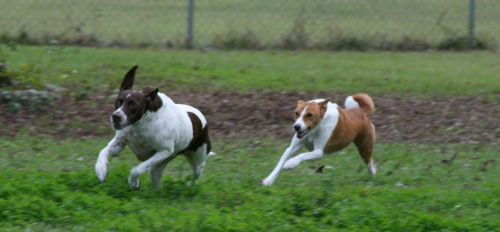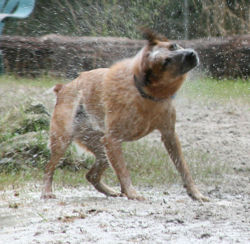Dog/Choosing a dog
When it comes to choosing a dog, "the best" is a fit between the animal and the owner. Beyond that, advice on dog selection really comes down to opinion. This article reviews the advice that has been repeatedly given by experts, such as dog breeders, kennel club officials, and veterinarians, in publications and lectures.That advice is discussed in a critical fashion, and links for finding a dog and for further education about making a choice are included in the last sections.
Despite best efforts, none of what is written here can be taken as a sure-fire prescription for success. People who are knowledgable about domestic canines uniformly advise against choosing a dog who is diseased, for example; and yet there are those dogs who have been nursed back to health by owners who swear that the special bond they have with the animal came about for just that reason. Of course, the usual outcome of choosing a sick animal is expensive and time-consuming at best. At worst, the dog is not helped despite the most dedicated efforts, and the experience compromises the new owner's physical and emotional health.
This article aims to examine the pros and cons of each choice of companion dog in detail. Hunters and herders, and others who are interested in choosing a proper working dog are best off consulting their peers rather than following any of the guidelines for pet dogs.
Where do you best find a dog? What should you pay?
Dogs and puppies are available at a great range of prices, from free to thousands of dollars, and from a great variety of places, from a next-door neighbors' accidental litter to a show hall in an exhibition center in an international city. Generally, purebred breed puppies are sold by stores and breeders, purebred adult dogs are adopted out by breeders and purebred rescue groups, and mixedbreed dogs are available from shelters and neighbors.
Although many puppies and dogs are given away, the "gift dog" may be as problematic to its recipient as the "gift horse" was to the Trojans. Mongrels (from shelters), and purebred dogs (from many sources), most often come with a purchase price or adoption fee that covers the cost of worming, vaccinations and a basic health evaluation. Oftentimes, that price also covers and spaying or castration (de-sexing surgery) and microchipping (a reliable means of pet identification). Taking on a "free" dog most often means that the new owner pays for these services.
So, in fact, adopting a free dog can turn out to be quite expensive. Has the dog had vetinerary care? Is that documented? A problem like heartworm infestation can be extraordinarily expensive to eradicate. The cost of vaccinations and neutering at a private vet's office is most often more expensive than the adoption fee from a rescue group or shelter, in which these services are included.
Shelters and Rescue Groups
There are animal shelters and rescue groups in many regions of the world that have dogs and puppies available for adoption. Many people who have taken in these animals have greatly benefited, and there may be some truth to the notion that the rescued dog appreciates its good fortune and makes the very best of all pets. There are certain aspects of adopting from a shelter, however, that must be acknowledged as risks.
Some shelters house dogs together in groups without first insuring that parasites and infectious diseases are not present. This can lead to adopting a dog or puppy who is in the early stages of an infestation or infection (caught while at the shelter) and not becoming aware of it until there is an obvious problem much later.By that time, some conditions (like the fungal infection known as ringworm) can be pased to members of the human family, and other conditions, that affect only canines, can have been passed to other family pets. Other shelters are very careful to avoid such "cross-contamination" of the healthy by the sick or parisitized, and the wise adopter checks on the policies carefully.
Socialization is another issue. Shelters (and breeders) who take pains to see that puppies are handled sufficiently to be socialized are the best places to find pups.
Most of the dogs and puppies that are in a shelter are there because of deficiencies in their previous owner's commitment to pet care - and through no fault of their own. However, although many dogs are abandoned by owners who were neglectful, some dogs are delivered to shelters because they have such stiff requirements for training and care that they can not fit into any average household. Either way, abandoned dogs will often pose pose challenges to the adoptor.
For example, dogs who are adults but have not had boundaries of proper behavior imposed as they grew up can be very difficult to live with, particularly if they are large and active or have not been housebroken successfully. Such dogs can make wonderful companions, if trained, but are best adopted by a person who is very experienced with dogs, and both able and willing to provide that training.
Additionally, dogs that are more difficult to train or that are more aggressive or rambunctious are more likely to be left at shelters than easy-going dogs. It is said by some that "there are no bad dogs", it is said by others that some individual dogs have either inherited tendencies towards aggressiveness ("turning" on people without clear cause or warning), or neurological damage, such that they are not safe for adoption. Many shelter workers and volunteers are skilled at evaluating dogs and can help steer the would-be adopter to an animal that is appropriate and likely to succeed in its new home. Other shelters are willing to adopt out any dog, no matter what its past behavior, and do not perform evaluations.
Rescue groups that care for giant breeds (like Great Danes) and large, potentially aggressive dogs (like Rottweilers) often insist that obedience training is mandatory after any adoption. Rescue groups and breeders who are sophisticated about the larger and more aggressive dogs know that an owner who can take over the dominant role with such a dog is likely to do very well, but that an owner who gets shy, nervous, or giddy around a bounding (or growling) dog weighing more than a hundred pounds is not a good choice for the dog. Placing such a dog with the wrong owner, from the point of view of the dog's welfare, is a poor decision. This is also true of breeds known for mischievousness and high energy, like a Jack Russell terrier or a Border Collie. These dogs are known to thrive on constant exersize and the physical work of herding or ratting. Placing a typical member of either breed in a home where it will be confined indoors and spend long periods alone is a recipe for disaster. The same dog, in a different environment, might do well with the same set of owners.
Mixed breed dogs are in the majority at shelters, and offer all the same qualities as purebred dogs but one. In young mixed breed dogs and puppies (those that are still growing), the adult height and weight, and to some degree temperament, are not as predictable as in the purebred dog. Often, this is of no concern, but for people who live in a small apartment who have other constraints, adopting an adult mixed breed dog or a purebred puppy of a suitable breed is probably a better choice.
Pet Stores
According to published sources by breed associations,and kennel clubs, stores that sell puppies are usually a problematic source for a new dog. Unless the store has special arrangements with breeders, and is staffed by knowledgeable people who are trained in proper care, purchasing a dog from a reputable breeder is considered much more reliable. How can a customer judge the quality of a pet store and its stock?
Healthy puppies are generally either very active, or sleeping soundly. A puppy who lies in a cage for long periods without doing either is probably sick. If the pet store being examined is full of racks of puppies laying in repose, that are not alert and lively for periods of time, this is a sign of real trouble. Similarly, although some breeds of dogs drool or tend to have some dicoloration of fur around their eyes, when many puppies. of several different breeds, are dirty with excrement around their bottoms and/or discharge around their eyes this is good evidence of poor hygiene and suggests that diseases such as infectious diarrhea and conjunctivitis (eye irritation) are present. Both can be signs of parasites as well as bacterial and viral infections.
The best thing to do is walk out the door, without buying a puppy. A health guarentee is not enough to make up for purchasing a sick puppy. You may be entitled to another puppy, but that is no compensation for the heartbreak that comes with dealing with the first one.
Breeders
The very best place to buy a purebred dog or puppy is from a reputable breeder. That said, finding a reputable breeder requires both work and luck. Most developed countries of the world have kennel clubs that register purebred dogs and sponsor dog shows and trials in which a purebred can win points towards a championship title. These clubs generally maintain lists of breeders who are "in good standing". Although those lists are a place to start - the very organizations that maintain them ordinarily warn that they cannot vouch for the quality of the puppies offered. At best, they can vouch that the breeders have broken no rules and are dues paying members.
Reputable and responsible breeders
Among breeders, there are certain criteria that are universally accepted as showing proper responsibility to the breed. Puppies are guarenteed against certain hereditary defects known to occur in the breed. Puppies are not sold before the age of 8-12 weeks under any circumstances. Applications are taken from prospective purchasers and restrictions are imposed. The most common restriction is that the puppy must be neutered, unless being sold as a breeder dog or showdog. If the dog is being sold as a breeder dog or showdog, the responsible breeder will generally insist that the adoptor already runs a recognized breeding operation, has a track record in the showring, or allows the breeder who is selling the puppy to either be a co-owner or to have the final say, once the pup is grown, if it is to be bred or nuetered, and if bred, which crosses are permissable.
Given all that, it's easy to see why pet stores have to have special relationships with breeders. Responsible breeders will not sell their puppies to pet stores if the purchasers are not fully screened. The breeders that do regularly sell their puppies to pet stores fall under the category of what is often called "puppy mills".
The two perjorative terms used by canine experts to denigrate particular breeding operation are "backyard breeders" and "puppy mills".
Backyard breeders
Puppy mills
What age is best?
Few of us can resist a puppy, but most of us are probably better off (on a practical level) with an older animal. Puppies require house breaking, and all go through a stage where chewing can be tremendously destructive. Managing puppies can be done by anyone with the time and inclination, and is certainly worth the effort - but usually involves the sacrifice of at least a couple of pairs of shoes! When a grown dog is available who is reliably housebroken, and who clearly responds to the new owner, an equally strong bond can develop between them without that kind of loss and aggravation.
How old a puppy?
"The best time to acquire a puppy is at 8-12 weeks of age." [1] That's because a puppy younger than that age may not be completely weaned, and may not have had time to adequately socialize with its littermates and mother. It is also at this age that the first series of vaccinations can be given.
Male or Female?
Children and Dogs
What breed?
Most breed organizations list not only the most common attributes of the breed, but also common genetic problems and special characteristics that require special care.
Size
Aggressiveness
Dogs that have been bred for generations to guard homes and livestock, or to fight each other, are ordinarily capable of aggression towards people. When well-trained, well bred dogs of these breeds are perfectly wonderful companion dogs.
Barking
Activity level
Dogs need physical exercise and mental stimulation to be healthy and well-behaved. The amount of each varies according to the individual and changes over the life of that individual. When making choices about adopting a companion dog, there are general guidelines about age and breed that can be helpful.
Most dogs, when young adults, need more intensive exercise than they can get while leashed to a human being. When let out in a large area, single dogs often do not burn off energy the way they will if accompanied by a person and other dogs in that same area. For those people who do not have several dogs and a large securely fenced yard (meaning most of us!), outings with fellow dog owners can provide healthful activities for both dogs and people.
If those sorts of outings are not practical on a regular and frequent basis, then the choice of a dog that has a lower activity requirement, or that is small enough to wear itself out running around in an indoor space, is wise.
Coat and Grooming, Allergy
Poodles are one of the few breeds of dogs that do not shed their hair. This trait makes them a better choice if allergy is a consideration.
External Sites
Adopting a rescued dog or puppy:
External Sites
Adopting a rescued cat or kitten:
Australia
Happy Paws' list of adoptable dogs and puppies in Australia.[1]
Canada
Pet Rescue and Adoption. This website maintains lists of rescue groups for domestic animals, including dogs, in Canada. [2]
Singapore
UK
UK Animal Rescuers maintains a website that acts as a public posting site for available animals. The following links to the "dogs" section. [3]
USA
Petfinder.com is a portal to a great number of combined rescue groups and shelters. Searchable database (with pictures) of domestic animals that are available for adoption. [4]
Notes
- ↑ James M Griffin, MD & Liisa D. Carlson, DVM . Dog Owner's Home Veterinary Handbook. Third Edition. Copyright 2000 (by authors) Published by Howell Book House NY. ISBN:0-87605-201-4 page 463





